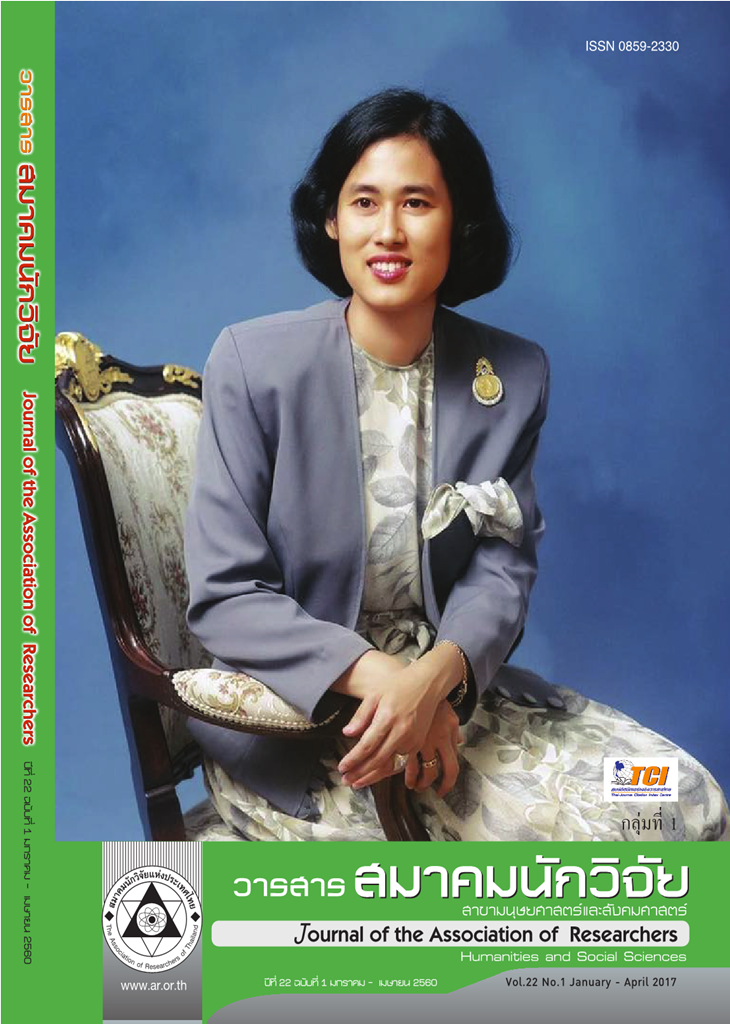Influences of Socially Responsible Leadership and Organizational Citizenship Behavior on CSR Activities Participation of Employee of Government Housing Bank
Main Article Content
Abstract
The objectives of this research were 1) to study the relationship among socially responsible leadership, organizational citizenship behavior and CSR activities participation of employee of Government Housing Bank, 2) to study the influence of socially responsible leadership on organizational citizenship behavior, 3) to study the direct and indirect effect of socially responsible leadership and direct effect of organizational citizenship behavior on CSR activities participation of employee of Government Housing Bank, and 4) to study the influence of organizational citizenship behavior on CSR activities participation of employee of Government Housing Bank. Sample was employees of Government Housing Bank. Simple random sampling was applied, and completely sample size was 400. The results found that correlation coefficient among observable variables were 0.456-0.690 and had a significant level at every variable. From structural equation modeling found that socially responsible leadership had influence on organizational citizenship behavior with significantly and the variance predicted by socially responsible leadership with 47.6 percent. Moreover, socially responsible leadership had influence on CSR activities participation with significantly and had indirect effect via organizational citizenship behavior with significantly and variance predicted by socially responsible leadership and organizational citizenship behavior at 34.2 percent. Finally, stakeholders’ perception of corporate social responsibility had direct effect to corporate image with significantly. Fit indices of the model were χ2/df = 3.302; CFI = 0.986; NNFI = 0.980; RMSEA = 0.076 and 90% CI for RMSEA = 0.061
Article Details
บทความที่ปรากฏในวารสารนี้ เป็นความรับผิดชอบของผู้เขียน ซึ่งสมาคมนักวิจัยไม่จำเป็นต้องเห็นด้วยเสมอไป การนำเสนอผลงานวิจัยและบทความในวารสารนี้ไปเผยแพร่สามารถกระทำได้ โดยระบุแหล่งอ้างอิงจาก "วารสารสมาคมนักวิจัย"
References
พิพัฒน์ นนทนาธรณ์. (2555). การจัดการจริยธรรมธุรกิจ: ฐานรากของซีเอสอาร์. กรุงเทพฯ: ศูนย์ผู้นำธุรกิจเพื่อสังคม.
_____________ (2558ก). บทบาทของซีเอสอาร์และวิสาหกิจเพื่อสังคมกับการแก้ปัญหาสังคม. วารสารพัฒนาสังคม.17(2), 13-34.
_____________ (2558ข). ภาวะผู้นำเชิงปฏิบัติการ: LIFE Model. (พิมพ์ครั้งที่ 2). กรุงเทพฯ: ศูนย์ผู้นำธุรกิจเพื่อสังคม.
_____________ (2558ค). “อิทธิพลของภาวะผู้นำที่รับผิดชอบต่อสังคมและพฤติกรรมการเป็นสมาชิกที่ดีขององค์การที่ ส่งผลต่อการมีส่วนร่วมในกิจกรรมด้านความรับผิดชอบต่อสังคมของพนักงานธนาคารออมสิน”. วารสารสมาคมนักวิจัย. 20(3), 61-71.
_____________ (2559). การจัดการความรับผิดชอบต่อสังคมขององค์กร: การสร้างข้อได้เปรียบในการแข่งขันอย่างยั่งยืน.(พิมพ์ครั้งที่ 2). กรุงเทพฯ: ศูนย์ผู้นำธุรกิจเพื่อสังคม.
ธนาคารอาคารสงเคราะห์. (2559ก). รายงานความรับผิดชอบต่อสังคม 2558 ธนาคารอาคารสงเคราะห์. กรุงเทพฯ:ธนาคารอาคารสงเคราะห์.
_____________ (2559ข). รายงานประจำปี 2558 ธนาคารอาคารสงเคราะห์. กรุงเทพฯ: ธอส..
References
Carroll, Archie (Ed.). (1977). Managing Corporate Social Responsibility. Boston: Little, Brown and Company.
Carroll, Archie B. & Buchholtz, Ann K. (2006). Business and Society (6th ed.). USA: Thomson SouthWestern.
Cheney, G., & Vibbert, S. L. (1987). Corporate Discourse: Public relations and issue management. In F. M.
Jablin, L. L. Putnam, K. H. Roberts, & L. W. Porter (Eds.), Handbook of Organizational Communication:An Interdisciplinary Perspective. (pp.165-194), Newbury Park, CA: Sage.
Cohen, John & Uphoff, Norman. (1980). 'Participation's place in rural development: Seeking clarity through specificity', World Development, 8: 213-235.
Diamantopoulos, A., & Siguaw, J. A. (2000). Introducing LISREL: A Guide for the Uninitiated. Thousand Oaks, CA: Sage.
Government Hosing Bank. (2016a). Annual Report 2105 Government Housing Bank. Bangkok: GHB.
_____________ (2016b). CSR Report 2105 Government Housing Bank. Bangkok: GHB.Hooper, Daire, Coughlan, Joseph & R. Mullen, Michael. (2008). Structural Equation Modeling: Guidelines for Determining Model Fit. Electronic Journal of Business Research Methods, 6 (1), 53 – 60.
Kotler, Philip, & Lee, Nancy. (2005). Corporate Social Responsibility. New Jersey: John Wiley & Sons.
_____________ (2008). Social Marketing: Influencing Behaviors for Good (3rd d.). Los Angeles: Sage.
_____________ (2009). Up and Out of Poverty: The Social Marketing Solution. Upper Saddle River: Wharton School.
Leech, N. L., Barrett, K. C., & Morgan, G. A. (2005). SPSS for Intermediate Statistics: Use and Interpretation(2nd ed.). Mahwah, NJ: Lawrence Erlbaum Associates.
Moon, Henry, Van Dyme, Linn & Wrobel, Krysia. (2004). “The Circumplex Model and the Future of Organizational Citizenship Behavior Research” In David L. Turnipseed (Ed.), Handbook of Organizational Citizenship Behavior (pp. 1-22). New York: Nova Science Publishers.
Nonthanathorn, Phiphat. (2012). Business Ethics Management: Foundation of CSR. Bangkok: Social Enterprise Leadership Center. (in Thai).
_____________ (2015a). “CSR and Social Enterprise Roles for Social Problem Solving. Journal of Social Development. 17(2), 13-34. (in Thai).
_____________ (2015b). Operational Leadership: LIFE Model. (2nd ed.). Bangkok: Social Enterprise Leadership Center. (in Thai).
_____________ (2015c). “Influence of Socially Responsible Leadership and Organizational Citizenship Behavior on CSR Activities Participation of Employee of Government Saving Bank”. Journal of Researcher Association. 20(3), 61-71. (in Thai).
_____________ (2016). Corporate Social Responsibility Management: Creating Sustainable Competitive Advantage. (2nd ed.). Bangkok: Social Enterprise Leadership Center. (in Thai).
Organ, D.W. (1988). Organizational Citizenship Behavior: The Goods Soldier Syndrome. Lexington, MA: Lexington Book.
Pless, Nicola M. (2007). “Understanding Responsible Leadership: Role Identity and Motivational Drivers”Journal of Business Ethics, 74:437-456.
Porter, Michael E. & Kramer, Mark R. (2006). “Strategy & Society: The Link between Competitive Advantage and Corporate Social Responsibility.” Harvard Business Review. HBR.ORG. December.
_____________ (2011). “Creating Shared Value: How to reinvent capitalism- and unleash a wave of


